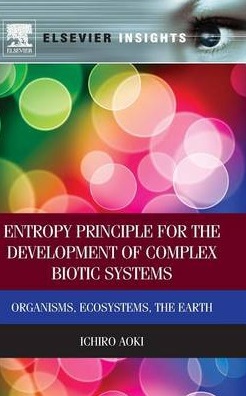
Entropy Principle for the Development of Complex Biotic Systems : Organisms, Ecosystems, the Earth
[Book Description]
The concept of entropy in thermodynamics is a complex one, though it is fundamental in understanding physics, the workings of the mind, and biology. Entropy is the measure of the quality of energy, and it can also refer to the turn from order to disorder or randomness in isolated systems. In open systems, such as biology, entropy is formulated in terms of production and energy flow. This book establishes a novel view of complex biological systems and the earth using this concept of entropy, encompassing the interdisciplinary area of biology, ecology and physics. This book considers the development over time of a range of biologically complex systems such as plants, animals, humans, and ecosystems, describing them in terms of the second law of thermodynamics, entropy. With its broad coverage of biological systems, this book will be useful for students of environmental science as well as students in biology and physics. It includes discussion of multiple complex systems including the earth and biological systems within it. Suitable for those with little physics background who wish to learn how the laws of physics apply to ecological systems, it is clearly organized by system, making information easy to access.
[Table of Contents]
Preface
1: Thermodynamics and Living Systems
1.1 Thermodynamics
1.2 Entropy Law
1.3 Entropy Production: Quantifiability in Living Systems
1.4 Maxwell's Demon
2: Plant leaves
2.1 Broad Leaves
2.2 Conifer Branches
2.3 Entropy Production at Night
2.4 Theorem of Oscillating Entropy Production
3: Animals
3.1 White-tailed Deer
3.2 Lizard
3.3 Pigs
4: Humans I. Direct Calorimetry
4.1 Direct Calorimetry: Outline and Significance
4.2 Calculation of Entropy Production
4.3 "Entropy Homeostasis"
4.4 Non-Basal Effects
5: Humans II. Indirect Calorimetry
5.1 Biological Meanings
5.2 Physical Formulation
5.3 Age Dependence I. Per Surface Area
5.4 Age Dependence II. Per Individual
6: Ecological Communities
6.1 Respiration
6.2 Trophic Diversity
6.3 Trophic Diversity vs. Respiration
6.4 Eutrophication
6.5 Arrow of Time
6.6 Dissipation Function and Entropy Production
6.7 Discussion
7: Lake Ecosystems
7.1 Methods of Calculation
7.2 Lake Biwa and Lake Mendota
7.3 Senescent Stages
8: Entropy Principle in Living Systems ("Min-Max Principle")
9: The Earth
9.1 Planets of the Solar System
9.2 Earth's Surface and Earth's Atmosphere
Remark 1 Global Warming
Remark 2 Gaia Hypothesis
Appendix Energy Budget Equation - the First Law of Thermodynamics
References

 新书报道
新书报道